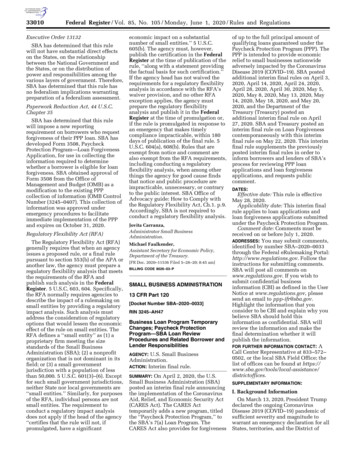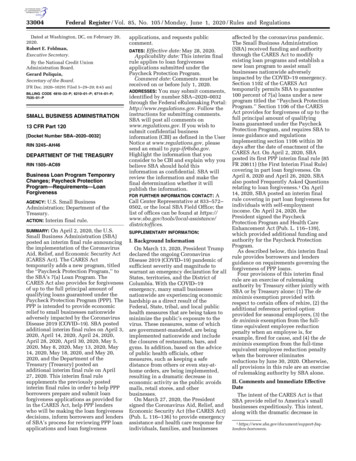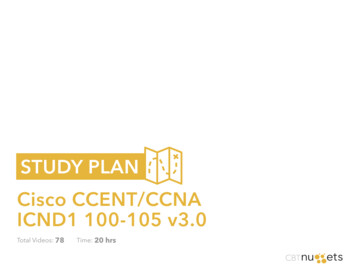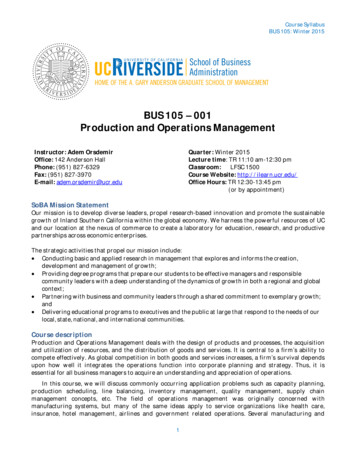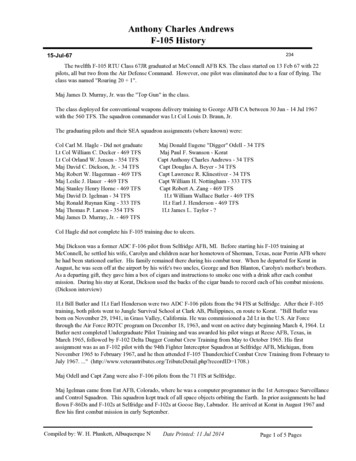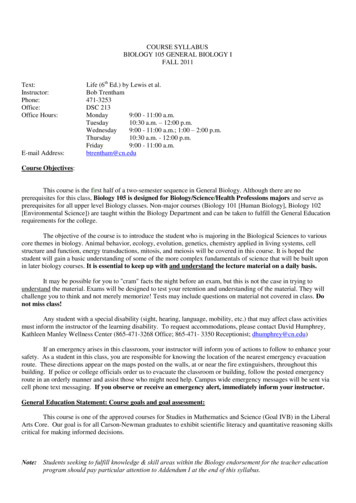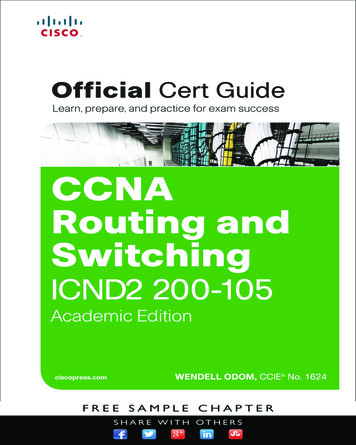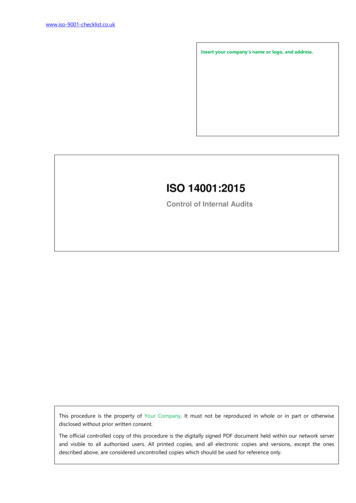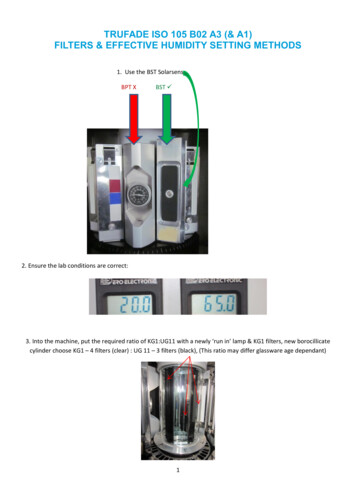
Transcription
TRUFADE ISO 105 B02 A3 (& A1)FILTERS & EFFECTIVE HUMIDITY SETTING METHODS1. Use the BST SolarsensBPT XBST 2. Ensure the lab conditions are correct:3. Into the machine, put the required ratio of KG1:UG11 with a newly ‘run in’ lamp & KG1 filters, new borocillicatecylinder choose KG1 – 4 filters (clear) : UG 11 – 3 filters (black), (This ratio may differ glassware age dependant)1
4. Select the ‘Standards’ Icon to find (in this case) ISO B02 105 A3 (also for reference see BS EN ISO 105-B02 Clause 7for parameters listings) – Once selected the panel will look like thhe picture below.3. Fill the chamber carousel with 1 x solarsens & 8 x specimen holders.4. Set the machine timer for an hour minimum & Press ‘Start’5. For A3, after around the time shown below (c. 40 mins) the machine should have settled down & reached therequired parameters and begin to maintain this. Although a little fluctuation is allowable this can be seen bywatching the dials. Additionally, to check the total accumulative mean tolerances – This is found in ‘Events’ &displayed in full at the end of the test – Check average: Irradiance W/m², Humidity RH% & Pnl temperature C( Solarsens is the Black Standard Thermometer ‘BST’).6. If you choose use the Black Panel Thermometer BPT and not the Black Panel Thermometer BST Solarsens asadvised, then it is necessary to try and control this through setting the chamber temperature at initiallyapproximately five degrees lower than the BPT listed in ISO 105 clause 7 Table 2 (it gives 40 /-3 C).For example, on the A3 setting selection, set the chamber temperature by pressing & holding the the right handtemperature dial ( C) to show a key pad and set in e.g. (40-5 ) 35 C to start with & start to run the machine.Then about every ½ hour watching through the door at the BPT temperature reading if it reads higher than 40 /-3 Cthen lower the temperature on the dial, if it reads lower than 40 /-3 C then raise the temperature setting until theneedle on the BPT on the carousel remains at constant 40 /-3 C. However generally all throughout the test, smalladjustments may still need to be made and so a constant eye is needed to be kept on the BPT – This is why werecommend using the solarsens as it makes these adjustments for you.7. This configuration allows for both A3 & A1 tests to be conducted without the need to change the filterconfiguration. However, if only A1 normal temperate condition testing is to be conducted, then there is no need touse UG11s, 7 x KG1s are adequate.2
8. Once the parameters are established, before any sample testing, remember to first set the effective humidityusing the red azoic humidity-test control fabric and corresponding blue wool (for A3 it is BW3 & A1 BW 5) to fade toa grey scale 4 simultaneously.This is standard practice – see BS EN ISO 105-B02 Clause 8.2 & Annex 4. And also the directions below:ACHIEVING THE CORRECT EFFECTIVE HUMIDITY FOR ISO 105 B02A3 SEMI TROPICAL CLIMATE SETTINGThere is no quick way to do this, it is time consuming but necessary and once found only requires small adjustmentsin the future – it is in the standard and a requirement for all individual machines in situ. The standardrecommendation is to conduct an effective humidity check every 3 months and after any movement or service.Select B02 Option 3 for A33
Make up the following fade cards holding 45mm x 10mm pieces of:Blue wool reference fabric number 3humidity test control fabric (red azoic)Put prepared card into the specimen holder and cover with a ½ mask:4
Place holder in chamber with blue wool 3 & humidity test control fabric (red azoic) on the card(Please note: This is an example picture only)Set the timer for 10 hours5
After 10 hours:(a) Allow the faded cards to stand in the dark & dry out.(b) Assess the humidity test control fabric (red azoic) – it needs to reach a shade change of a Grey scale 4.If the humidity test control fabric (red azoic) has not reached a grey scale 4 put the fade cards back in foranother 5 hours & repeat points (a) & (b)If the humidity test control fabric (red azoic) has still not reached a grey scale 4 put the fade cards back infor another 2 hours & repeat points (a) & (b)If the humidity test control fabric (red azoic) has again still not reached a grey scale 4 put the fade cardsback in for another 1 hours & repeat points (a) & (b)Keep doing this until the humidity test control fabric (red azoic) has reached a grey scale 4Please understand that the timings above are a guide only if the humidity test control fabric (red azoic)seems to be fading very quickly then shorten the test time intervals, if it seems to be taking a long timethen extend the test interval times – It is trial and error, but better to use caution with the test durationsbecause you do not want the humidity test control fabric (red azoic) to go past the grey scale 4 grade asthen the test will be ruined and you will have to start again.Once the humidity test control fabric (red azoic) has reached a grey scale 4, you then you check thehumidity test control fabric (red azoic) against the blue wool reference 3 fabric & if it has faded the same asthe blue wool then you know that the optimum effective humidity is established and the RH% is setcorrectly.You are looking for the humidity test control fabric (red azoic) to reach a Greyscale 4 and the Blue Woolreference fabric to match the fade of the humidity test control fabric (red azoic). When this happens youknow that the effective humidity is correct and the RH% is correctly set.6
It is very likely that this will not happen on the first test fade and the humidity test control fabric (red azoic)will either be faded more or less than the blue wool reference fabric. If this occurs, then you will havechange the RH% on the dial to do a new test.If the humidity test control fabric (red azoic) has faded more than the blue wool then the effective humidityIs too high & so needs lowering on the dial (illustration only you may to make differentadjustments & also here, focus only on setting the central dial – ignore the outer dial readings in thisillustration).If the humidity test control fabric (red azoic) has faded less than the blue wool then the effective humidityis too low& so needs increasing on the dial (illustration only).7
To change the RH% on the dial touch the centre of the Humidity dialThe numeric keyboard will appear – type in the humidity level you think you will need (remember this istrial and error & the amount you increase or decrease the RH% number by depends upon how different thefade steps are between the humidity test control fabric (red azoic) and the blue wool fabric fades whencompared to each other).Estimation adjustment RH% figure based on last test8Set by selecting the ‘tick’
Make up a new card and do the test again to the newly set RH% and check as before until the humidity testcontrol fabric (red azoic) reaches a grey scale 4 and once again check against the blue wool.Hopefully the adjustment made will mean that the shade difference in the humidity test control fabric (redazoic) and the blue wool will appear equal now, but if not repeat the process again until the two fabricfades match when the humidity test control fabric (red azoic) equals a grey scale 4 – You have thenachieved the optimum effective humidity & RH% setting.Adjust RH% againDown or Up:DownORUp9
Effective Humidity & correct %RH setting achievedNB: Example %RH above the RH you achieve may be different.Testing to other climate settingsIf you want to check the A1 effective humidity follow the same method but use: A1 (Temperate climate with normal humidity) use BW5 looking for a fade contrast equal to GS4ONCE THE EFFECTIVE HUMIDITY IS SET, SPECIMEN TESTING CAN BEGIN.10
TRUFADE ISO 105 B02 A3 (& A1) FILTERS & EFFECTIVE HUMIDITY SETTING METHODS 1. Use the BST Solarsens BPT X BST 2. Ensure the lab conditions are correct: 3. Into the machine, put the required ratio of KG1:UG11 with a newly run in lamp & KG1 filters, new borocillicate cylinder choose KG1 – 4 filters (clear) : UG 11 – 3 filters (black), (This ratio may differ glassware age dependant) 2 4 .

